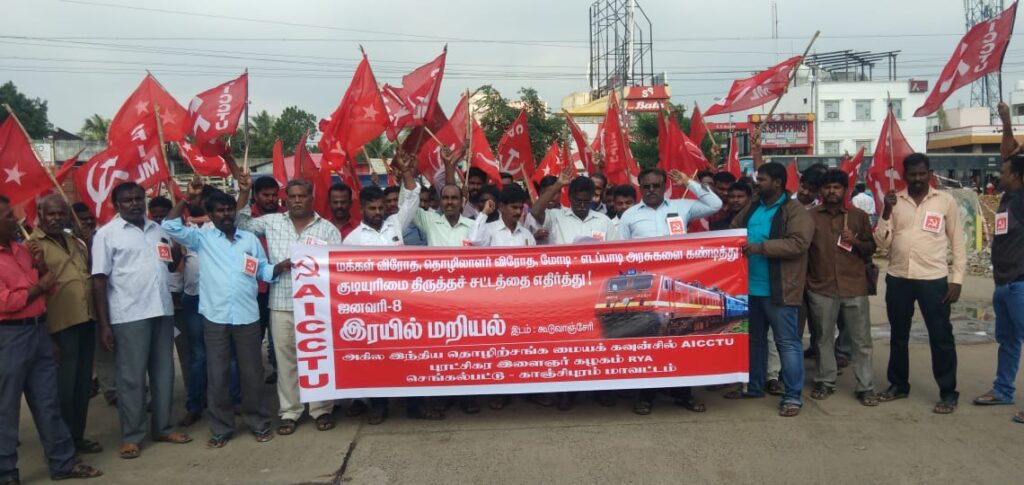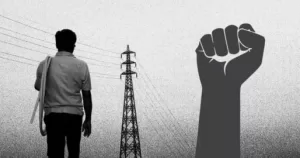Two Day Bharat Bandh Against ‘Govt’s Anti-People Policies’
The Wire Staff
Bharat Bandh: Day One
The two-day Bharat Bandh called by a joint forum of central trade unions with the alleged support of nearly 20 crore workers in the country, began on Monday, March 28, from 6 am.
The strike is expected to impact the functioning of numerous sectors all over the country, including banking, power, transportation, and more.
The decision to call the nationwide strike came after a meeting of the joint forum in Delhi on March 22. According to a statement issued by the joint platform then, the protest is against the “anti-worker, anti-farmer, anti-people and anti-national policies” of the Union government.
According to Amarjeet Kaur, general-secretary of the All India Trade Union Congress (AITUC), 20 crore workers from 10 central trade unions are expected to participate in the strike.
Apart from the AITUC, these include the Indian National Trade Union Congress (INTUC), Hind Mazdoor Sabha (HMS), Centre of Indian Trade Unions (CITU), All India United Trade Union Centre (AIUTUC), Trade Union Coordination Centre (TUCC), Self Employed Women’s Association (SEWA), All India Central Council of Trade Unions (AICCTU), Labour Progressive Federation (LPF) and United Trade Union Congress (UTUC).
Besides, organisations such as the All India Bank Employees Association (AIBEA) and farmers body the Samyukt Kisan Morcha (SKM) have also extended support to the movement.
The Bharatiya Mazdoor Sangh (BMS), which has affiliations to the Hindu organisation, the Rashtriya Swayamsevak Sangh (RSS), said that it will not participate in the strike, calling it “politically motivated”.
Support for the bandh has come from many states across the country. According to Kaur, the entire coal mining belt of Jharkhand, Chhattisgarh and Madhya Pradesh are participating, and that there has been a “good response” from the industrial areas of Assam, Haryana, Delhi, West Bengal, Telangana, Kerala, Tamil Nadu, Karnataka, Bihar, Punjab, Rajasthan, Goa and Odisha.
Their demands include the scrapping of the labour codes, no privatisation of any form, scrapping of the National Monetisation Pipeline (NMP), increased allocation of wages under MNREGA (Mahatma Gandhi Rural Employment Guarantee Act) and regularisation of contract workers, among others.
Ahead of the bandh, the power ministry issued an advisory to all state governments and electricity authorities to prepare for the disruption and ensure that all grids function normally, around the clock on March 28 and 29. It also asked all regional and state control rooms to remain on high alert during the protest period.
Banking services were impacted in several regions due to the strike, given the involvement of AIBEA employees in the bandh. However, according to an Economic Times report, this effects were limited to public sector banks and were felt more prominently in the eastern regions of the country.
Some banks, such as the State Bank of India (SBI), had warned customers of disruptions before the bandh began.
Bank unions are reportedly protesting against the Union government’s decision to privatise two more public sector banks, as announced in the Union Budget 2022. Apart from the AIBEA, the Bank Employees Federation of India (BEFI) and All India Bank Officers’ Association (AIBOA) are also part of the two-day strike.
West Bengal
Protestors in West Bengal were seen putting up rail and road blockades in the state to stop vehicles from plying. At the Jadavpur Railway Station, members of the opposition Left Front alliance were seen gathering in large numbers to block the tracks.
Meanwhile, at Kulgachhia station, two Left Front workers were reportedly injured after a narrow escape while trying to stop a moving train. The train was reportedly moving in order to get the protestors off the tracks.
However, when the bandh was announced, the Mamata Banerjee-led Trinamool Congress (TMC) state government declared in a memorandum that all state government offices would remain open through March 28 and 29.
It also noted that no employee of these offices would be granted personal or casual leave on these days.
The government’s decision drew flak from trade union leaders for not supporting their cause. Anand Sahu, the Bengal chief of the CITU told news agency PTI that, “The dispensation (of the TMC) is showing its true colours by opposing the strike which has been called to protest against the Narendra Modi regime’s policies against workers, farmers and general people.”
Kerala
Government offices remained closed across Kerala on the first day of the protest and the state was characterised by empty streets. This was not just restricted to public transport as reports came in of protestors stopping private vehicles from plying as well.
State-run KSRTC buses did not operate while taxis, auto-rickshaws and private buses kept away from the roads across the state. Commercial vehicles including trucks and lorries are also not plying, in solidarity with the strike.
Emergency services, however, were exempt from the bandh, which included hospital and ambulance services, as well as the delivery of milk, newspapers, and so on. State police also arranged for transport facilities for those who have reached the Thiruvananthapuram Central Railway station to travel to the Regional Cancer Centre.
Protestors, however, tried to prevent employees of Bharat Petroleum Corporation Limited (BPCL) from entering the office premises in Kochi. The Kerala high court on Friday had prevented employees from five trade unions in the company from participating in the protest.
Tamil Nadu
Similarly in Tamil Nadu, public transport has seen considerable disruptions with only 20% of buses reportedly plying. The LPF, one of the trade unions part of the joint committee which called the strike, is affiliated with the ruling Dravida Munnetra Kazhagam (DMK) party in the state.
Trade union workers and members of Left parties were also seen protesting and blocking road and rail traffic in Vijaywada in Andhra Pradesh, Bhubaneswar in Odisha, among other parts of the country.
Bharat Bandh: Day 2
The ‘Bharat Bandh’ strike, called for by ten central trade unions against the “anti-worker, anti-farmer, anti-people and anti-national policies” of the Union government, moved into its second and final day on Tuesday, March 29.
The unions are protesting against the reduction in the Employee Provident Fund Organisation (EPFO) interest rates; the sudden hikes in petrol, diesel, liquified petroleum gas (LPG), kerosene and compressed natural gas (CNG) prices; and the introduction of the four new labour codes.
Their demands included the scrapping of the labour codes, no privatisation of any form, scrapping of the National Monetisation Pipeline (NMP), increased allocation of wages under MNREGA (Mahatma Gandhi Rural Employment Guarantee Act) and regularisation of contract workers, among others.
The first day of the protest had seen disruptions in transportation, banking and other services in several states, with near-empty streets being seen in Kerala and widespread demonstrations by members of Left parties in West Bengal. Disruptions were also seen in Tamil Nadu and Delhi, among others.
Essential services, such as medical and ambulance services, the delivery of newspapers and essential items, and so on, remained unaffected.
The Wire had reported on all the major developments of the first day of protests.
Amarjeet Kaur, general-secretary of All India Trade Union Congress (AITUC), on of the unions which was part of the joint committee which called for the bandh, stood by her earlier claim that 20 crore workers participated in the protest.
“Workers in Sikkim and Arunachal Pradesh have joined the strike on the second day,” Kaur said.
On Tuesday, workers from various sectors as well as members of the trade unions gathered at Jantar Mantar, amid the ongoing general strike.
Speaking to The Wire at Jantar Mantar, Kaur said that the strike was no longer in opposition to specific privatisation policies, but against the “total selling-out of the country’s resources” by the Bharatiya Janata Party (BJP) and the Narendra Modi government.
“Our scheme workers, construction workers, labourers have conducted the protests by stopping railway lines, disrupting commercial activity and restricting movement across several states. The anger of the last two years, against the treatment of workers and the workforce by the Modi government, has been pouring in in the form of symbolic resistance over the last two days,” she added.
Speaking to The Wire about the protest so far, Tapan Sen, general-secretary of the Centre of Indian Trade Unions (CITU), said, “A complete halt has been observed. Transport workers have particularly joined the strike in a big way, specially against the labour codes, the government’s crackdown on unions and its encouragement of contractualisation. The anger on the ground has made this strike successful.”
Street vendors, Anganwadi and ASHA workers, construction workers, contractual staff across organisations were among those present at the demonstration at Jantar Mantar.
Banking services disrupted
Employees of bank unions, such as the All India Bank Employees Association (AIBEA), too, extended support to the protest. During the course of yesterday’s protest, they were joined by employees of the Bank Employees Federation of India (BEFI) and All India Bank Officers’ Association (AIBOA).
While new-age, private banks were largely unaffected by the strike, public sector banks in several states had their services disrupted as many employees did not show up for work.
The bank unions are protesting against the Union government’s decision to privatise two more public sector banks, as announced in the Union Budget 2022. They are also demanding an increase in interest rates on deposits and a reduction in service charges.
Apart from banks, workers from the manufacturing sector across the country, as well as those from public sector offices, agriculture, ports, docks and more are reportedly part of the protest. What’s more, the protest has garnered support from students, unemployed youths, artists and intellectuals as well.
More states, sectors join in
On Monday, Kaur had claimed that the entire coal mining belt of Jharkhand, Chhattisgarh and Madhya Pradesh are participating, and that there has been a “good response” from the industrial areas of Assam, Haryana, Delhi, West Bengal, Telangana, Kerala, Tamil Nadu, Karnataka, Bihar, Punjab, Rajasthan, Goa and Odisha.
On Tuesday, employees of the Haryana roadways reportedly joined in on the protests, causing disruptions in transport in the state.
Similarly, protests from the Centre of Indian Trade Unions (CITU), another union part of the joint committee, and Left parties made their way to Karnataka.
Moreover, thousands of employees from the Steel Authority of India Limited (SAIL), Visakhapatnam-based steel producer Rashtriya Ispat Nigam Limited (RINL) and the National Mineral Development Corporation (NMDC) joined the bandh, Mint reported.
Kerala high court intervenes
Kerala was one of the states which felt the most severe impacts of the bandh, with images of deserted streets surfacing online. Moreover, reports emerged of protestors blocking the passage of even private vehicles.
On Monday, while hearing a plea by lawyer Chandra Chooden Nair S. demanding the compulsory attendance of employees during the bandh, the Kerala high court directed the state’s Left Democratic Front (LDF) government to issue orders preventing government employees from abstaining from work.
The court also directed the state to also issue orders enabling the operation of vehicles so that employees can report for duty.
Citing Rule 86 of the Kerala Government Servants’ Conduct Rules, the court said, “Government servants should not engage themselves in any concerted or organised slowing down or attempt at slowing down government work or in any act, which has the tendency to impede the reasonably efficient and speedy transaction of government work. Concerted or organised refusal on the part of government servants to receive their pay will entail severe disciplinary action.”
“…we are of the view that the government should also take adequate steps to prevent the government servants from engaging in any activity specified in Rule 86,” the bench added.
Shortly after the court’s ruling, the state government issued dies-non (no work, no pay) order for employees participating in the strike who would take an unauthorised leave of absence from their work.
The order also said no leave of any kind will be granted to government employees unless there is sickness of the individual or relatives like wife, children, father and mother.
Before the bandh, the Mamata Banerjee-led Trinamool Congress (TMC) government in West Bengal had issued a similar order preventing employees from any kind of casual or personal leave on March 28 and 29.
Tuesday also saw Congress Rajya Sabha MP Shaktisinh Gohil give a Suspension of Business notice in the upper house to discuss the two-day strike.
“That the House do suspend Zero Hour and relevant rules relating to Question Hour and other business of the day to have a discussion on two-day nationwide strike by central trade unions to protest against Government’s policies that are affecting farmers, workers and people,” news agency ANI quoted the suspension notice as saying.
(Courtesy: The Wire.)




